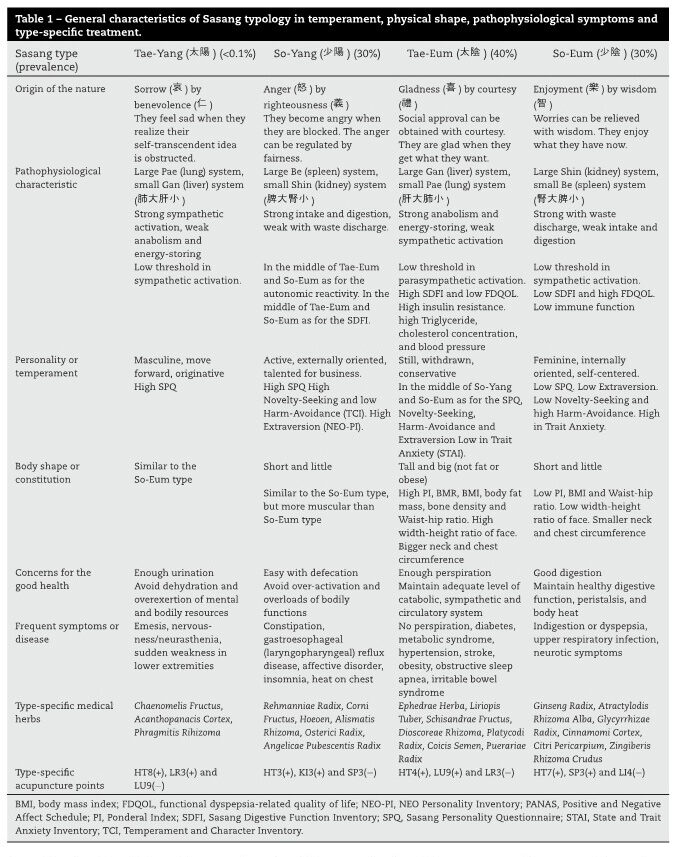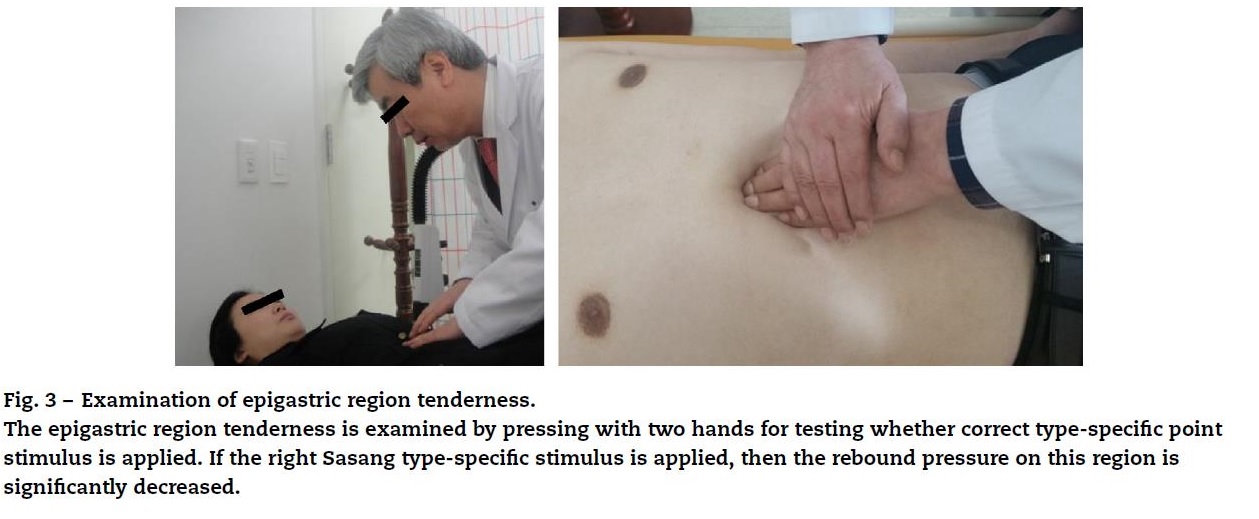Han Chae(a), Jeongyun Lee(b,c), EunSang Jeon(d), JaeKyu Kim(e)
<Integrative Medicine Research; 6 ( 2 0 1 7 ) 329–336> |
Introduction
The personalized medicine for effective and safe treatment has long been of interest since Hippocrates and Galen of the West and Yellow Emperor and Ayurveda of the East and was encouraged with the recent Human Genome Project.1–3 The Sasang typology is a traditional Korean personalized medicine systematically theorized by Jema Lee (1837–1900) and his book Longevity and Life Preservation in Eastern Medicine (1894, 1900) ased on Confucius understandings on human nature and thousands years of clinical experiences in Korea.2–5
The Sasang typology divides people into four Sasang types, Tae-Yang, So-Yang, Tae-Eum, and So-Eum, with type-specific psy-chobiological traits2,6 and pathophysiological symptoms.7,8 The Sasang type-specific treatments with medical herbs9 and acupuncture could be applied considering one’s Sasang type in combination with cold–hot subgroup and severity of the illness (Table 1).
 Although the Sasang typology showed its clinical usefulness10–17 and seems relatively simple, the clinical application of Sasang type-specific treatment has not been easy even with many articles and books on it. In many cases, clinicians have failed to incorporate it from the mis-understandings on theories and limited understanding on diagnosis, thereby making the clinical usefulness of Sasang typology suspicious. Therefore, evidence-based and detailed explanations on the diagnosis and treatment of a patient with Sasang typology are needed for the interested clini-cians. In this review, we systematically describe the clinical application of Sasang typology from the Sasang type differ-entiation with type-specific pathophysiological symptoms7,8 to the Tae-Geuk (Tai-Chi in English) Acupuncture (TGA) with type-specific acupuncture points.8,18
Although the Sasang typology showed its clinical usefulness10–17 and seems relatively simple, the clinical application of Sasang type-specific treatment has not been easy even with many articles and books on it. In many cases, clinicians have failed to incorporate it from the mis-understandings on theories and limited understanding on diagnosis, thereby making the clinical usefulness of Sasang typology suspicious. Therefore, evidence-based and detailed explanations on the diagnosis and treatment of a patient with Sasang typology are needed for the interested clini-cians. In this review, we systematically describe the clinical application of Sasang typology from the Sasang type differ-entiation with type-specific pathophysiological symptoms7,8 to the Tae-Geuk (Tai-Chi in English) Acupuncture (TGA) with type-specific acupuncture points.8,18
TGA was originally suggested by Dr Byunhaeng Lee with reference to the Sasang typology and clinical experiences in 1974,19 and Dr Jaekyu Kim introduced the clinical examination technique of Insang Park and Jungjae Kim20 and reported its clinical efficacy previously.18,21
Jema Lee wrote his experience with type-specific acupunc-ture treatment in his book as “Previously, I have met So-Eum Sasang type patient suffering from digestive system qi prob-lems and was successfully treated with acupuncture on LI4. And I also experienced immediate effects of acupunc-ture treatment that the medications couldn’t get. Since there would be acupuncture technique useful for the Sasang typology, the Sasang type-specific points and manipulation technique should be improvised to control the Sasang type-specific pathophysiological mechanisms.”4



Though TGA was not suggested in Jema Lee’s original book, it was systematized by the clinical specialist of acupuncture, and its clinical efficacy on chronic pains in multiple sites and psychosomatic complaints were supported with retrospec-tive studies.18,20–22 TGA was reported to be useful for instant confirmation of Sasang type differentiation with simple test; however, it was out of reach for the foreign clinicians until now since up-to-date reports on Sasang type differentiation2,6–8,23 have not been supplemented with detailed clinical procedures of TGA.
This study would provide clinical procedures of acupunc-ture treatment with Sasang typology (Fig. 1) along with general features of each Sasang type for diagnosis (Table 1; Fig. 2), Sasang type-specific acupuncture points (Table 1), and methods for examining clinical response to TGA (Fig. 3). It would provide a gateway for Sasang type-specific acupunc-ture treatment and more structured clinical research on its effectiveness.24
references
- 1. di Sarsina PR, Alivia M, Guadagni P. Traditional, complementary and alternative medical systems and their contribution to personalisation, prediction and prevention in medicine—person-centred medicine. EPMA J 2012;3:15.
- 2. Lee SJ, Park SH, Cloninger CR, Kim YH, Hwang M, Chae H. Biopsychological traits of Sasang typology based on Sasang personality questionnaire and body mass index. BMC Complement Altern Med 2014;14:315.
- 3. Chae H, Lyoo IK, Lee SJ, Cho S, Bae H, Hong M, et al. An alternative way to individualized medicine: psychological and physical traits of Sasang typology. J Altern Complement Med 2003;9:519–28.
- 4. Lee JM. Longevity and life preservation in Eastern Medicine. Seoul, Korea: Jae Ma Lee; 1894.
- 5. Leem KH, Park HK. Traditional Korean medicine: now and the future. Neurol Res 2007;29:S3–4.
- 6. Chae H, Kown Y. Best-fit index for describing physical perspectives in Sasang typology. Integr Med Res 2015;4:20–8.
- 7. Han YR, Lee HB, Han SY, Kim BJ, Lee SJ, Chae H. Systematic review on type-specific pathophysiological symptoms of Sasang typology. Integr Med Res 2016;5:83–98.
- 8. Lee MS, Sohn K, Kim YH, Hwang MW, Kwon YK, Bae NY, et al. Digestive system-related pathophysiological symptoms of Sasang typology: Systematic review. Integr Med Res 2013;2:39–48.
- 9. LIm SH, Jeon ES, Lee M, Han SY, Chae H. Pharmacognostic outlooks on medical herbs of Sasang typology. Integr Med Res; Submitted http://dx.doi.org/10.1016/j.imr.2017.06.005.
- 10. Cho NH, Kim JY, Kim SS, Lee SK, Shin C. Predicting type 2 diabetes using Sasang constitutional medicine. J Diabetes Investig 2014;5:525–32.
- 11. Lee J, Lee J, Lee E, Yoo J, Kim Y, Koh B. The Sasang constitutional types can act as a risk factor for hypertension. Clin Exp Hypertens 2011;33:525–32.
- 12. Lee TG, Koh B, Lee S. Sasang constitution as a risk factor for diabetes mellitus: A cross-sectional study. Evid Based Complement Alternat Med 2009;6:99–103.
- 13. Park SJ, Bae YC, Choi NR, Ryu SY, Kwon YM, Joo JC. Clinical study on constitutional herbal tea for treating chronic fatigue. J Pharmacopuncture 2014;17:55–60.
- 14. Cho NH, Kim JY, Kim SS, Shin C. The relationship of metabolic syndrome and constitutional medicine for the prediction of cardiovascular disease. Diabetes Metab Syndr 2013;7:226–32.
- 15. Choi MH, Chae H, Lee SJ. Analysis of the association between problem behaviors and Sasang typology in high school students. Integr Med Res 2016;5:110–7.
- 16. Lee MS, Shin BC, Choi SM, Kim JY. Randomized clinical trials of constitutional acupuncture: a systematic review. Evid Based Complement Alternat Med 2009;6:59–64.
- 17. Yin C, Park HJ, Chae Y, Ha E, Park HK, Lee HS, et al. Korean acupuncture: the individualized and practical acupuncture. Neurol Res 2007;29:S10–5.
- 18. Chae H, Kim Y, Hwang EH, Kwon Y, Lee S. Study on the effect of Sasang psychobiological factors on general health status. Korean J Orient Physiol Pathol 2014;28:452–9.
- 19. Lee B. Study on the origin of acupucture. The Hanbang Chunchwoo 1974:1.
- 20. Kim J-K. Clinical opinion of Taegeuk Acupuncture treatment by Sasang constitutional medicine. J Korean Acupunct Moxibustion Soc 2011;28:69–73.
21. Kim KH, Kim JK, Yang GY, Lee BR, Noh SH. Acupuncture for management of balance impairment in a patient with bipolar disorder. J Acupunct Meridian Stud 2013;6:56–9. - 22. Park S, Kang K, Kim S, Hwang S, Chae H. Systematic review on the study of Sasang typology published in Korea from 2000 to 2009. Korean J Orient Physiol Pathol 2011;25:721–7.
- 23. Lee SJ, Cloninger CR, Cloninger KM, Chae H. The temperament and character inventory for integrative medicine. J Orient Neuropsychiatry 2014;25:213–24.
- 24. White A. Acupuncture and constitutional diagnosis: where now? Acupunct Med 2011;29:247–8.



































